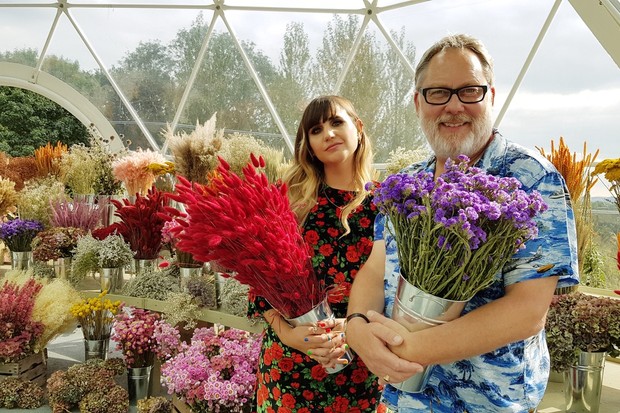At first glance, The Big Flower Fight seems like a niche spin-off of the famed The Great British Baking Show; after all, every single person on the planet has a relationship with food, but many do not have the time or space to garden. I, for one, didn’t think the program could be that interesting. However, Flower Fight successfully captures one’s attention, largely benefitting from the scale on which it operates. While the famous Baking Show simply operates within a kitchen, the central competition in Flower Fight revolves around mammoth sculptures. Ten teams of two have several hours to build the massive floral installations, with the winners receiving the chance to create an installation of their own in London’s Kew Gardens. The sheer size, as well as the abundance of color, is sure to impress any viewer, regardless of their personal gardening experience.
I will, of course, admit my bias. I am a proud member of the Hoya Hive and maintain beehives on campus. While I do not pretend to know plants and flowers nearly as well as the competitors, I have a familiarity and an appreciation for flowers. Further, the first floral sculpture featured on The Big Flower Fight was an eight-foot honeybee, snatching my attention and cultivating an interest from the very beginning. In fact, one of the judging criteria for this first round involved selecting flowers that attract bees and pollinators, something my fellow beekeepers have been trying to promote on Georgetown’s campus. Nevertheless, I can assure any reader that a floral background is not a prerequisite for enjoying the botanic beauty of the series.
Although floral monuments serve as the program’s centerpiece, the majority of the charm is derived from the colorful cast. Not to be limited to the British Isles, the cast of The Big Flower Fight also draws florists, artists, and landscapers from Denmark, the Netherlands, and the United States. Like The Great British Baking Show, the competitors are from a variety of backgrounds: Black florists create a DNA stand-themed project featuring tropical flowers from Africa and the Caribbean, and a transgender cast member is portrayed as normal, rather than extraordinary. I would be remiss if I did not mention Yan & Henck, Dutch & Danish florists with a flair for the flamboyant. Each episode, these two were as colorful as their creations, donning chef’s hats, neon overalls, or hair colored to resemble a watermelon.
As is apparent in The Great British Baking Show, the cast becomes more comfortable with themselves and each other as the competition proceeds. The cast becomes more confident on-camera, delivering one-liners and letting their personalities emerge, and develops a clear camaraderie. Although the premise of the program is inherently competitive, the cast members are not afraid to help each other, reminding me of competitors consoling each other over burnt pasties in Baking Show. This innate goodness in humanity is refreshing in modern television, especially reality-competition series, and adds a layer of depth to its characters. They are, after all, real people with careers, dreams, and aspirations.
As the cast opens up, the aforementioned representation only grows. In the penultimate round of the competition, one young competitor dedicates a topiary installation to his anxiety, depicting his demons in a touching manner. The beast has uneven bark as fangs, and its arms, covered in prickly red plants, prevent any escape. The focus on the creature’s arms and mouth is revealed as the competitor sits inside the maw of the beast, indicating just how enveloping anxiety can be. As one might anticipate, the materialization of his insecurities proves draining, but with the support of his father, a simple landscaper from the English countryside, the two finish and draw tears from their competitors. Not only is it incredibly refreshing to see people on a television program be so open about the complicated relationship between masculinity and vulnerability, but for it to come from ordinary men gives me hope that similar conversations may become more common and less stigmatized. Although the show centers on a competition regarding flowers, human moments like these are effortlessly interwoven into the narrative.
Like its cast, the production of The Big Flower Fight blossoms over the progression of the program. I found the editing of the first episode to be somewhat uneven; the majority of the hour focuses on the eventual finalists and the first teams eliminated. The second episode showed slight improvement and featured the previously hidden teams, but as the number of teams dwindled, the editing showcased the casts’ personalities in a well-rounded manner. And to its credit, the show condenses 15 hours of physical labor each episode into dramatic and delightful montages. Watching people plant flowers for hours on end is not nearly as boring as it may sound.
Honestly, The Big Flower Fight is, in some ways, more entertaining than The Great British Baking Show, despite the high levels of name recognition for the latter. While the Baking Show is rather limited in ingredients, The Big Flower Fight incorporates a variety of materials, from lumber to welded metal, and displays the dazzling species diversity present in plants. The comparisons I draw between these shows do not serve to undermine the popularity of The Great British Baking Show, but rather garner support for a rising star in competition programs. Not everyone has to be a gardener or florist, but in an era where climate concerns are mounting, the mainstreaming of flowers is more important than ever. I can only hope that viewers will be inspired to become bona fide tree huggers or, with the knowledge gleaned from the show, prefer the company of hydrangeas or gerberas, instead.





